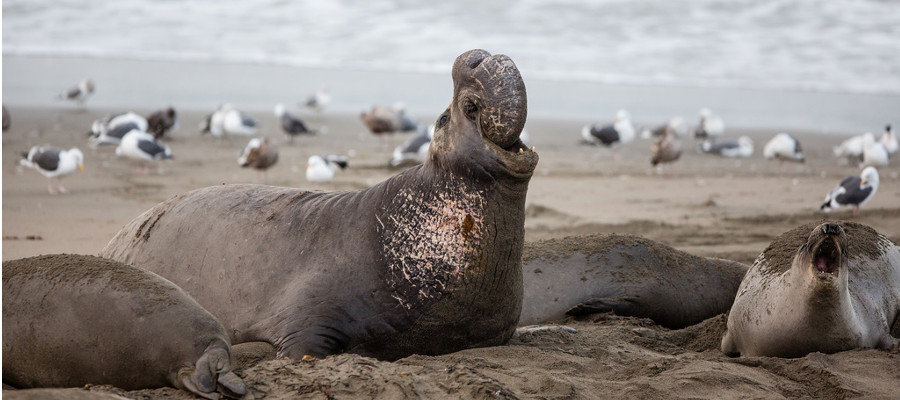Antarctica Seals: Pictures, Facts and Information

Because of seals beautiful fur coats and oily blubber, they were hunted in the late 18th and 19th centuries on a vast scale. In fact, much of the early Antarctic exploration was due to seals.
Nowadays seals are a protected species and thrive in Antarctica. With little in the way of predators (except for the odd killer whale!), seals are remarkably relaxed when it comes to humans and will often be more curious than anything else.
One of the joys of an Antarctica cruise is being able to observe seals up close.
Whilst only 6 of the 35 species of seal live in Antarctica, these 6 species actually make up the vast majority of all seals on earth. The 6 species are Antarctic Fur Seals, Leopard Seals, Ross Seals, Southern Elephant seals, Crabeater Seals and Weddell Seals.
Because of their thick layer of blubber and fur, Antarctica seals are extremely well-adapted to the freezing conditions and actually often find the conditions too hot, having to take plunges into the water to cool down. Seals are carnivorous and, depending on the type of seal, eat fish, krill or squid.
Seals can be categorized into three families – True seals, eared seals and walruses. Walruses are found in the arctic and eared seals (common to most zoos) are usually found in more temperate climates.
Except for the fur seal, all Antarctica seals are ‘True seals’ and exhibit no ears. Despite this, Antarctica seals can hear just as well as we can and under water they can hear far better than us.
Scientists believe that seals use a type of sonar, very much like dolphins, to locate prey. Their long whiskers are also believed to be able to detect the slightest movement in a certain direction.
With both sonar capabilities combined, seals can actually locate prey in complete darkness better than they can in day light.
In terms of vision, seals have sharp eyesight, but can not see colours especially well. However, they detect natural sea water hues like green and blue extremely well.
Like other low light hunters such as cats, seals have a have a silvery lining behind the retina that enables seals to absorb far more light than humans can which is ideal for hunting in the deep, dimly lit ocean.
Seals spend most of their lives in the sea and only really come ashore to breed during the Antarctica high tourist season. Living at sea most of their life, seals can often hold their breath in excess of 30 minutes and actually sleep below the surface of the water, coming up to breathe frequently without waking.
Below we have provided information on each species of Antarctica seal and where is best to see them.
Save Big on Your Antarctic Cruise
Antarctic cruise deals don’t last long – some cabins sell for 30–40% less than the regular price.
We check every major provider each month to uncover limited-time offers so you can experience the world’s last great wilderness for less.
Antarctica Seals
Weddell Seal

Without doubt one of the cutest looking seals in Antarctica, Wedell seals tend to stay in groups on inland fast ice during the Antarctic summer months.
During the breeding season these groups can often be in excess of 200 seals. Because of this, Wedell seals are one of the more commonly seen seals on an Antarctica cruise. During the breeding season it is common to see the male Wedell seals fighting their territorial battles.
Wedell seals are unusual in the fact that they will always choose to lie on snow or ice, even if rock or warmer ground is available.
Their love of ice and their need to avoid Killer whales means these creatures tend to avoid pack ice and seek breeding grounds further inland.
Wedell Seal Facts:
Size and weight: The average length of a Wedell seal is 3 metres with the females being slightly longer. The average weight of a Wedell seal is roughly 450 kg.
Feeding: Feeding mainly on fish, squid and krill, Wedell seals are one of the best divers in the seal kingdom and can dive in excess of a 1,500 feet in search of prey. In order to do this, Wedell seals can slow their heart rate, limit blood circulation and carry 5 times the amount of oxygen in their blood as humans do to reach these depths.
Breeding Season: Females are pregnant for 11 months and pups are born from September to November. A female will usually have 2 pups every 3 years.
World Population: It is estimated that there is between 500,000 and 1 million Wedell seals.
Distribution: The Wedell seal is the most southerly breeding animal on earth. The Wedell seal can often be found on sub-antarctic islands.
Conservation Status: Protected by the Antarctic treaty, Wedell seals have a conservation status of least concern.
Predators: Like most Antarctica seals, the Wedell seals has very few predators. The only one is the Killer whale. The Wedell seal was a favourite of sledders as food for their dogs. However, this practice ceased in 1994 and the population doing very well.
Southern Elephant Seals

Southern elephant seals are the largest seals on earth and the males can reach weights of up to 4,000 kg (8,800lb).
Whilst they are big and lumbering on land, Elephant seals are incredibly good swimmers and often dive down in excess of 2 km! Biologists have regularly recorded Elephant seals staying under water for 2 hours.
The males are far larger than the females and, because of this, dominate the breeding season. Males will first establish their territory in the busy beach by fighting other males. The spoils are often a harem of females 50 strong.
Fights between male Elephant seals are actually quite rare as most of the males can size each other up before the fight and work out which male will win.
Fights only break out when both males are of a very similar size. Males will usually only have one season as beach master. This is because the constant stress, wakefulness, fighting and hunger means males cannot keep it up for a second season.
Southern Elephant seals tend to gather on large beaches in extraordinary numbers. They pack so tightly together that the seals often lie on top of each other and pups are regularly killed because of the cramped space.
Up until 1964, Elephant seals were killed on mass because of their thick blubber layers and populations became alarmingly low. Nowadays though, Elephant seal populations are very healthy and most commonly seen on South Georgia.
The best Antarctica cruise option to see elephant seals is the Antarctica via Falklands and South Georgia Cruise.
Southern Elephant Seal Facts:
Size and weight: The average length of a male Elephant seal is 5 metres with an average weight of 2,500 kg (5,500klb). Females are usually 2.5 metres in length and weigh about 500 kg (1,100lb)
Feeding: Males and females generally feed separately, but both eat roughly 75% squid and 25% fish – particularly Notothenids (Antarctic cod).
Breeding Season: September to October is when the pups are born, very quickly after the females arrive. The mothers spend 3 weeks on the beach with their pups before they head to sea. The pups then spend a further 8 to 10 weeks on the beach before heading to sea themselves.
World Population: The most recent population estimate was in 1996 which gave an estimate of 650,000.
Distribution: Elephant seals are found throughout Antarctica but prefer the slightly more temperate areas north of the peninsula. The Falkland Islands and South Georgia are the best place to see them.
Conservation Status: Protected by the Antarctic treaty, Southern Elephant seals have a conservation status of least concern.
Predators: Killer whales will take Elephant seals, as will large sharks. Leopard seals have also been known to kill Elephant seal pups.
Antarctic Fur Seal

The smallest seals in Antarctica, the Southern fur seal is actually closely related to dogs and sea lions. Like both creatures, fur seals have long whiskers, sharp teeth and a similar thick fur coat. Like other Antarctica seals, Fur seals don’t have layers of fat. Instead, fur seals rely on their extremely thick fur coat to keep their bodies warm. Fur seals are usually a dark colour, however, you will occasionally see a blonde fur seal.
Unlike Elephant seals, female fur seals are not gathered into harems, instead, males fight over territory and then mate with the females that choose his territory. Therefore, popular beach sites are hard-fought as males occupying top breeding sites will often mate with over 100 females in one season.
The female is responsible for raising the pups and, unlike other seals, Fur seals will actively hunt and feed during the breeding season and do not rely simply on their milk to sustain their pups. Females will generally forage fish along the coast whilst males will hunt further out to sea.
During the 19th century, Fur seals were almost hunted to extinction with their world population dropping below 5,000! Luckily, in the 1930’s, Fur seals were placed under protection and their numbers have rapidly increased once again.
The best place to see Fur seals is now on South Georgia where 95% of the worlds Fur seals reside.
Antarctic Fur Seal Facts:
Size and weight: Males weigh roughly 150 kg and the females weigh on average 35 kg. Typical length is about 1.8 meters for a male and 1.3 meters for a female.
Feeding: Krill is their main source of food, however, if Krill is no available Fur seals will eat fish, squid and, occasionally, penguins.
Breeding Season: Females give birth in November and December. Males arrive around a month earlier than the females to establish territory. Females stay with their pups for 4 months.
World Population: There is estimated 5 – 7 million Fur seals worldwide with population ever-increasing.
Distribution: Southern Fur seals tend to reside in the sub-Antarctic islands, particularly on South Georgia.
Conservation Status: Protected by the Antarctic treaty, Fur seals have a conservation status of least concern.
Predators: Leopard seals hunt Fur seal pups to such an extent that it may cause a population decrease soon.
Leopard Seal

Easily identified with its long slender body, pretty markings and large fore-flippers, the Leopard seal is one of Antarctica’s best predators.
Its large jaw contains a set of complex and extremely sharp teeth that are used to tear through everything from fish and seals, to penguins, squid and krill.
Leopard seals are not frequently seen as they tend to be solitary creatures, inhabiting pack ice around the Antarctic coast. Leopard seals can travel great distances and are often seem off the coast of Australia!
Leopard seals will literally eat anything they can get their teeth on, including a wide array of seals and penguins.
Strangely, different Leopard seals tend to prefer different prey with some Leopard seals following seal colonies whilst others follow penguin colonies.
Unlike most seal breeds, female Leopard seals are larger than the males and have a somewhat ‘reptilian’ look about them that comes from the long neck and side facing eyes.
Leopard Seal Facts:
Size and weight: Males can weigh up to 300kg whilst females can weigh up to 500kg. Males are typically 3 meters long and females 3.5 meters.
Feeding: Seal pups and penguins are their main source of food, however, Leopard seals will eat fish, squid and, occasionally, krill also.
Breeding Season: Breeding generally between November and December on the pack ice, however, in the sub-Antarctic Islands pups can be born around August and September.
World Population: 300,000 was the last estimate, however, because of their elusive nature, recording their number accurately is very difficult.
Distribution: Can be found over a large area. Most frequently seen on large blocks of pack ice around the Antarctic coast. Best place to spot them is in open water near any large penguin colony.
Conservation Status: Protected by the Antarctic treaty, Fur seals have a conservation status of least concern.
Predators: Only the Killer whale, although this is not common.
Save Big on Your Antarctic Cruise
Antarctic cruise deals don’t last long – some cabins sell for 30–40% less than the regular price.
We check every major provider each month to uncover limited-time offers so you can experience the world’s last great wilderness for less.
Crabeater Seal

By far the most abundant seal in Antarctica, the Crabeater seal is actually the most numerous large mammal in the world after humans with an estimated population of roughly 15 million. The crabeater seal is one of the most common seals to spot during an Antarctica cruise.
Although often seen in small packs, Crabeater seals tend to be solitary creatures and their fur colour can range from blonde to very dark brown. They spend their entire live around Antarctica, laying in the pack ice zones where they breed, moult and rest.
They can actually cover great distances, however, this is often due more to the pack ice moving than any real long distance swimming. Despite their name, Crabeater seals actually feed almost solely on krill. In fact, Crabeater seals have specially designed teeth that allow them to strain out krill from the mouthfuls of seawater.
Because males do not need to be large to compete for harems, females and males are roughly the same size. Whilst most Antarctica seals seem not to care about human presence, Crabeater seals are amazingly timid and will often look around nervously at the surrounding land. If a human approaches they will generally slip into the water and swim away.
Crabeater Seal Facts:
Size and weight: Crabeater seals generally weigh around 250 kg (500lb) and are typically 2.5 meters in length.
Feeding: Krill is the main source of food for all Crabeater seals.
Breeding Season: Pups tend to be born anywhere between September and December and are weened at roughly 3 weeks. By this time the pups are only starting to grow a full fur coat.
World Population: 15 million is the current estimate, however, estimates range from between 10 and 20 million.
Distribution: Most frequently located on large blocks of drifting pack ice around the Antarctic coast. One of the most southerly living species in the world.
Conservation Status: Protected by the Antarctic treaty, Fur seals have a conservation status of least concern.
Predators: Killer whales and Leopard seals. Leopard seals are said to kill roughly 80% of all crabeater pups. If you look closely, most Crabeater seals carry scars along their side – evidence of past scraps with Leopard seals.
Ross Seal

The Ross seal is the least known, least common and smallest of all Antarctica seals. Because of their solitary nature and their rare distribution, extremely little is known about Ross seals.
Preferring to live in the densest pack ice, Ross seals can be identified bu their silvery-white tummies underneath a brown upper body. Ross seals tend to have quite small heads with big bright eyes. The size of the eyes may be an adaptation for hunting the deep, murky water.
Ross seals have very small mouths with little needle like teeth that are well adapted to catching slippery prey. Ross seals also produce a strange twittering siren like sound that can be heard above and below water. Scientists are unsure what this noise does, however, they can be heard at very long-range which may be used as a form of avoidance or encounter.
Best chance to see Ross Seals is on the Ross Seal Cruise.
Ross Seal Facts:
Size and weight: Ross seals generally weigh around 200 kg (400lb) and are typically 2.5 meters in length.
Feeding: Fish and squid is the main diet for Ross seals.
Breeding Season: Pups are born on the ice in November and weened after just 4 weeks. Ross seals are thought to mate underwater, however, this has never been witnessed. Pups reach sexual maturity at three years of age.
World Population: 130,000 is the rough estimate that scientists have given. This is very difficult to estimate though as so few are seem each year.
Distribution: Rarely seen, Ross seals rarely stray from the Antarctic region, preferring dense pack ice.
Conservation Status: Protected by the Antarctic treaty, Fur seals have a conservation status of least concern.
Predators: Killer whales and Leopard seals are presumably predators of the Ross seal, however, there is no actual evidence to support this.
Save Big on Your Antarctic Cruise
Antarctic cruise deals don’t last long – some cabins sell for 30–40% less than the regular price. We check every major provider each month to uncover limited-time offers so you can experience the world’s last great wilderness for less.

Mark W
USA
FAQ
If you would like to know more about Antarctica seals please leave a comment below and we will endeavor to get back to you within 24 hours! Alternatively, please see our FAQ page here. If you would like to get a cruise quote, please use this form.
Thank you - AntarcticaGuide Team

Vincent Kipkemoi Rono says
7 years ago